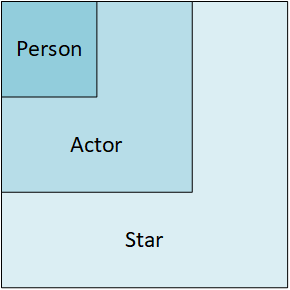| UML Class Diagram | Abstract Representation |
|---|---|
 |
Recalling that inheritance is an is-a relationship, we can say that "a Star is-an Actor" and "an Actor is-a Person." Together, these relationships imply that "a Star is-a Person." The order in which the compiler "sees" the class specifications is significant - it reads and processes each source code (.cpp) file once, from top to bottom. When a program instantiates a Star object, it allocates memory to hold it, which implies that the compiler must know the size of a Star object, including the embedded Actor and Person objects, at compile time. Another way of thinking about the challenge presented by the class specification order is whenever the compiler encounters an identifier, such as a class name, it must be previously declared and entered into the symbol table.
The classes in this example don't solve an algorithmically complex or interesting problem. Instead, information is "pushed up" through the inheritance hierarchy by chaining constructor calls, and information is "pulled down" through the hierarchy by chaining calls to the overridden display function.